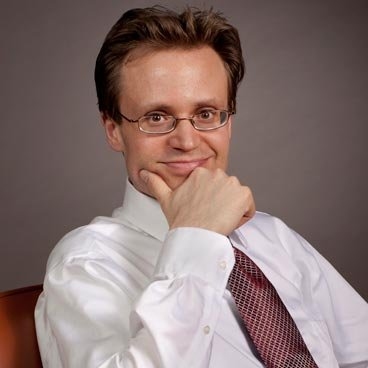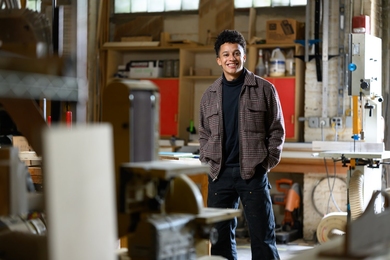Emphasizing the need to think outside disciplinary boundaries in research and education, to build and invent, and to foster an entrepreneurial spirit among students and faculty, Professor Markus Buehler, head of the Department of Civil and Environmental Engineering (CEE), laid out his vision for the department in a presentation to alumni at the first CEE New Research Breakfast held Oct. 17 in the Bush Room.
Buehler — who in his own research draws on natural systems and hierarchical materials like bone to understand and design stronger, lighter human-made materials — compared the urban environment to a glial cell. Referring to slides of a cell and an aerial photo of a lighted city, he pointed out a likeness between the appearance of the two and similarities in their networks for messaging, moving materials and other functions. Glial cells, which form a structure to support neurons, also supply them with nutrients and protect them from pathogens, much as the city’s transportation, information and infrastructure systems serve its inhabitants.
Understanding and modeling urban environments as systems is one of the world’s ongoing major challenges, he said, and one in which CEE researchers are taking the lead by “building quantitative models of cities to improve the health of both infrastructure and the environment, and modeling human behavior as well as influencing it,” he said. “Studying natural systems can help us do this better.”
Four other CEE faculty gave short presentations at the breakfast, which was organized by development officer Paul Hohenberger as an annual event for alumni in the Northeast to gather in October, hear a State of the Department address, and learn about ongoing and new interdisciplinary research and educational programs.
“We’ve entered a new era with a renewed focus on students and education that emphasizes the entrepreneurial spirit: going out into the world and creating things,” Buehler said in his address. “These inspiring faculty presentations provide a snapshot of the exciting research and educational work done in CEE. The cutting-edge research provides great opportunities for our undergraduate and graduate students — in classroom and laboratory education and research projects.”
Other speakers at the event were Associate Professor Colette Heald, whose talk was titled "How Air Pollution and Climate Impact Global Food Security"; Assistant Professor Pedro Reis, who spoke on "Smorphs: Turn Mechanical Failure into Functionality"; Assistant Professor Marta González, who discussed "Mining Cellphone Data to Improve Urban Livability"; and Professor Philip Gschwend, who spoke about "Benign Design of Materials Now Can Avoid Problems in the Future."
Applying tools like nanotechnology, urban physics and environmental microbiology to these and other areas — such as materials design, oceans, alternative energy grids and resources, biomes and ecosystems, the health of the planet and coastal processes — allow CEE researchers to see that all things are connected, said Buehler. "This approach forms the fabric of CEE at MIT," he said.
Read the full article
Buehler — who in his own research draws on natural systems and hierarchical materials like bone to understand and design stronger, lighter human-made materials — compared the urban environment to a glial cell. Referring to slides of a cell and an aerial photo of a lighted city, he pointed out a likeness between the appearance of the two and similarities in their networks for messaging, moving materials and other functions. Glial cells, which form a structure to support neurons, also supply them with nutrients and protect them from pathogens, much as the city’s transportation, information and infrastructure systems serve its inhabitants.
Understanding and modeling urban environments as systems is one of the world’s ongoing major challenges, he said, and one in which CEE researchers are taking the lead by “building quantitative models of cities to improve the health of both infrastructure and the environment, and modeling human behavior as well as influencing it,” he said. “Studying natural systems can help us do this better.”
Four other CEE faculty gave short presentations at the breakfast, which was organized by development officer Paul Hohenberger as an annual event for alumni in the Northeast to gather in October, hear a State of the Department address, and learn about ongoing and new interdisciplinary research and educational programs.
“We’ve entered a new era with a renewed focus on students and education that emphasizes the entrepreneurial spirit: going out into the world and creating things,” Buehler said in his address. “These inspiring faculty presentations provide a snapshot of the exciting research and educational work done in CEE. The cutting-edge research provides great opportunities for our undergraduate and graduate students — in classroom and laboratory education and research projects.”
Other speakers at the event were Associate Professor Colette Heald, whose talk was titled "How Air Pollution and Climate Impact Global Food Security"; Assistant Professor Pedro Reis, who spoke on "Smorphs: Turn Mechanical Failure into Functionality"; Assistant Professor Marta González, who discussed "Mining Cellphone Data to Improve Urban Livability"; and Professor Philip Gschwend, who spoke about "Benign Design of Materials Now Can Avoid Problems in the Future."
Applying tools like nanotechnology, urban physics and environmental microbiology to these and other areas — such as materials design, oceans, alternative energy grids and resources, biomes and ecosystems, the health of the planet and coastal processes — allow CEE researchers to see that all things are connected, said Buehler. "This approach forms the fabric of CEE at MIT," he said.
Read the full article






